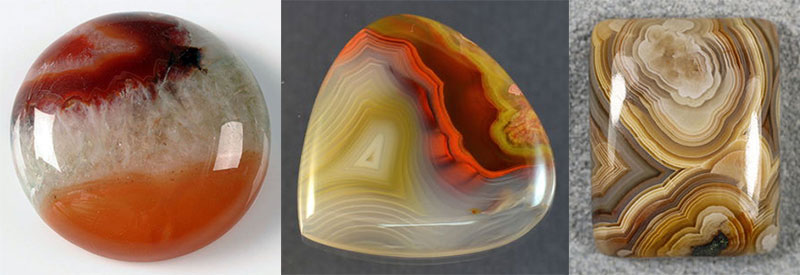Agate gemstone
Home ➤ Encyclopedia of gems ➤ Agate gemstonePhysical properties of agate
| Hardness: | 6.5-7 out of 10 on the Mohs scale |
| Gloss: | matte |
| Transparency: | translucent, opaque |
| Color: | white, grey, blue, yellow, green, red, black, multicolor |
Characteristics of agate
Agate (Owl's Eye, Spectacle Agate, Dendrite, Bastion Agate, Frost Agate, Rainbow Agate, Cloud Agate, Flame Agate, Swallow Agate) is one of the most amazing gemstones, although it is only a variety of the common gemstone quartz. First of all, because of the specific layered structure. Moreover, the pattern of these stripes (and they are concentric or linear) sometimes creates amazing pictures. But more on that later.
Agate has been known to mankind for a long time. And at all times this stone was valued by people. Moreover, according to one version, the name of the stone comes from the Greek word "ahates", which means "happy" in translation. True, according to another version, the name comes from the Sicilian river Ahates, where agates were mined a long time ago, but I think fans of this stone will like the first version more.

The color scheme of the stone is very diverse - from white and yellow to green and black (now black agates have become especially popular). And very often the colors of the stripes, even in one stone, can be very different. There are, for example, specimens with concentric colored layers similar to the eye (they are even called respectively - "owl's eye", "eye" or "spectacle agate"). In such agates, only 1 cm wide, there can be about 7000 different layers. Of course, it is impossible to see such a number of layers and colors with the naked eye, but these stones look very impressive and beautiful.
Sometimes numerous layers of agate are formed into patterns and even paintings. The pattern on the stone, reminiscent of forest thickets, is highly valued by the inhabitants of the East. They even came up with a separate name for such stones - moss agate. And agates with a tree-like pattern are called dendrites or dendritic stones (from the Greek dendron is translated as “tree”). Or the drawing can seem to emerge from the fog - such stones are called "frost agates". Also, sometimes the layers form something similar to an old map of some fortress - these are fortress, fortification and bastion agates. There are also other varieties of agate - cloudy, rainbow, fiery and others.
Known varieties of agate:
- eye agate (spectacle agate, owl's eye) - agate stones with concentric layers, the patterns of which look like an eye
- moss agate (dendritic agate) - stones with a pattern similar to moss or tree branches
- bastion agate - stones with a pattern reminiscent of fortresses or bastions
- landscape agate - stones with a pattern that is similar to those of landscapes
- iridescent agate (iris agate, skambia) - stones with very thin layers that create an iridescent color
- fire agate (flame agate) - stones with inclusions that create a bright rainbow color, sometimes similar to a flame
- ribbon agate - stones with straight parallel layers similar to ribbons
- frosty agate - stones with inclusions forming a pattern similar to swirling snowflakes
- cirrus agate - stones with a pattern similar to cirrus clouds
- star agate - stones with a star pattern
However, this is only an approximate division. After all, each pattern of each individual agate is unique. For example, the ancient Greek historian Pliny talks about the agate stone, which received the name "Pyrrhus stone", in the patterns of which one could see a picture with Apollo and nine muses. And some varieties of agate got their own separate names, no less famous - for example, onyx or sardonyx.
Even in ancient times, cameos were carved from agate - drawings with convex images. Moreover, the masters used the natural pattern of agate in such a way that it favorably emphasized the picture that the artist depicted. Intaglios were also made from agate - stones with a carved pattern used as a seal. Cameos and intaglios were very popular among the nobility, and some were even framed with diamonds or other very expensive stones.
And yet, despite the foregoing, agate is a fairly inexpensive stone. It may be because of its widespread use.
| ★ Labrador gemstone | |
| See also: | ★ Verdelite gemstone |
| ★ Almandine gemstone |





